Robotic surgery. The term may conjure an image of WALL-E, C3PO or the Terminator masked up and wielding a scalpel in the operating room.
That’s far from reality, but more and more robotic systems are finding their way into Maine hospitals, even the more rural hospitals. And they’re not only improving health care, they’re attracting physicians to those smaller hospitals, according to Central Maine Healthcare urologist Dr. Christopher Foote.
Within the last decade, both of Lewiston’s hospitals started using robotic systems for certain procedures, providing specialized surgeries not available here 10 years ago. It has meant patients who once had to go to Portland or Boston can get treatment closer to home.
“(Some) people who come to see me from western Maine … can barely get the resources to drive an hour and a half to Lewiston and there’s no way they’d make it to Boston or even to Portland,” Foote said.
Lewiston’s hospitals now perform a host of surgeries assisted robotically, including joint replacements, urological surgeries and cancer care.
For instance, before he started working at Central Maine Healthcare about three years ago, the hospital did not provide surgical prostate cancer management and offered limited care for other types of urological cancers, he said.
Though both St. Mary’s Regional Medical Center and Central Maine Medical Center use different robotic assisted surgery systems for different types of procedures, their benefits are much the same. Cuts are more precise, patient stays after surgery are shorter and incidences of corrective surgery afterward are less frequent, doctors said. Patients also tend to feel less pain during recovery.

Dr. Christopher Foote and registered nurse Anna Wilson fit the da Vinci robot with instruments Wednesday at Central Maine Medical Center in Lewiston. The robot is operated by the surgeon who is across the room at a console, while another surgeon and a certified scrub technician stay bedside with the patient. Andree Kehn/Sun Journal
Robotic systems are also ergonomically better for surgeons performing procedures, Foote said. More traditional surgeries require doctors to hunch over a sedated patient for several hours at a time, so many of them suffer from back problems, which can shorten their careers. Many robotic systems allow surgeons to move around and take “microbreaks.”
It allows them to do complex surgeries while maintaining a more proper posture, he said. It also reduces fatigue during surgeries so doctors can perform more procedures.
Central Maine Orthopedics surgeon Michael DeFrance swears by the Mako Robotic-Arm Assisted Surgery he uses to do knee and joint replacements. In traditional knee replacement procedures, surgeons typically use long skinny rods to estimate where prosthetics should go and make cuts based on visual estimations during surgery, but robotic systems are more precise.
The human margin of error for knee replacements is 3 degrees in either direction of the joint, but his robotic system reduces that margin to half a degree or less, DeFrance said.
“Humans are fraught with error and we know that our margin is way larger than what the robot’s margin of error is,” he said.
The Mako system will stop if a cut is made even a half of a millimeter outside the surgical plan, resulting in fewer injuries to soft tissue, according to DeFrance.
Robotic surgery systems for joint replacements tend to use a wand-like hand-held device that the surgeon moves over a person’s joint allowing software on a screen nearby to create an image of the joint.
The CORI system that orthopedic surgeon Dr. Boris Kovalenko uses at St. Mary’s helps him define the alignment, form and balance of a knee during replacement surgery, he said. He uses X-rays and clinical exams to evaluate a person’s anatomy before surgery. He uses the robotic system to get a more functional fit for each knee replacement.
Foote uses the da Vinci XI robotic surgical system in procedures related to kidney and prostate removals because of cancer, along with reconstructive surgery.
In the past eight years, the number of surgeries using robotic systems in urology has soared. The robotic arms essentially have “wrists and hands and other multiuse tools” that make it easier to use in surgeries, Foote said.

Dr. Christopher Foote, background, operates the da Vinci robot instruments Wednesday at Central Maine Medical Center in Lewiston. The surgeon has a 3D view of what the robot is doing, which is also shown on a screen in the operating room, and is shown in the upper right. Andree Kehn/Sun Journal
Some of the da Vinci robotic tools look like small crab pincers, slowly and meticulously cutting flesh with more precision than a human hand. Other surgical tools on the system look like tiny, gripped pliers.
Probably one of the biggest improvements with using robotic systems compared to more traditional procedures within urology is the lack of blood loss, he said. Since he started using the da Vinci system he has not had to give patients a blood transfusion during simple prostatectomies, radical prostatectomies and partial nephrectomies, which had been a common occurrence with traditional surgeries.
One of the drawbacks of using a robotic arm during surgery is not being able to feel the patient’s body with his hands when placing stitches, Foote said, but the robotic system compensates for that by providing extensive imagery that gives him better visuals for the stitching process.
‘FANCIER GADGETS’
Though robotic surgery seems like a more recent invention, the technology has been around since the late 1980s.
Original funding for robotic systems came from a Defense Advanced Research Projects Agency initiative to create systems that allow surgeons to perform procedures from a distance, according to Raymond Lanzafame, executive director and chairperson of the Society of Laparoscopic and Robotic Surgeons. It was also an effort to enhance surgical performance and make advancements in minimally invasive laparoscopic surgery.
The earliest robotic surgeries in the U.S. started in 1988, but the systems did not start being more commonly used until a few years after that, he said. Robotic systems at that time were more like assistants. It was not until the late 1990s that the da Vinci system received U.S. Food and Drug Administration approvals. Until the past few years the robotic surgery systems market only consisted of a few companies.
It takes a while before new technologies become widely used in the medical field, and the cost of the systems is substantial, but research suggests that when hospitals buy a robot-assisted surgical system it quickly becomes the primary surgical tool for whatever specialized care the machine was created for.
When hospitals adopt robotic technology, it significantly increases the surgical volume of procedures specific to the system, according to a 2022 article published in the National Library of Medicine. The article stated that of the 151 hospitals researchers evaluated with robotic capabilities, there was a 37% increase in surgical volume in those facilities because of robotic technology.
In the past decade, hospitals started to invest in robotic systems, which resulted in more surgeons learning how to use them, Foote said. As more people learned how to use them, doctors started pushing for their hospitals to invest in the systems.
“It was almost a self-fulfilling prophecy,” he said.
Lanzafame thinks eventually robotic instruments will become interchangeable among the various manufacturers, whereas each system has its own instruments that cannot be used with another company’s system.
Surgical robot systems are not capable of performing surgery themselves, but Lanzafame thinks they could be autonomous to some degree at some point in the more distant future. However, now the idea is still “science fiction.”
“There’s no question the technologies are a major advance and, you know, there’s ultimately more on the way in applications in multiple disciplines, but in this point in time it’s not press the button and the machine does the work,” Lanzafame said.

Dr. Christopher Foote and registered nurse Anna Wilson get the da Vinci robot ready for surgery Wednesday at Central Maine Medical Center in Lewiston. Foot believes that as robotic systems continue to develop they will get more minimally invasive and there will be more surgical tools to use with them. Andree Kehn/Sun Journal
Foote does not see the surgeon ever being taken out of the robotic surgery process, he said. Now, there is no artificial intelligence component to the system he uses, he is in full control of the robotic arm.
He does see robotic systems becoming more minimally invasive, he said. He also thinks companies will develop more types of tools that can be used in robotic surgery. “Where it’s going is fancier gadgets basically,” he said. “Tools that do extra things.”
Send questions/comments to the editors.


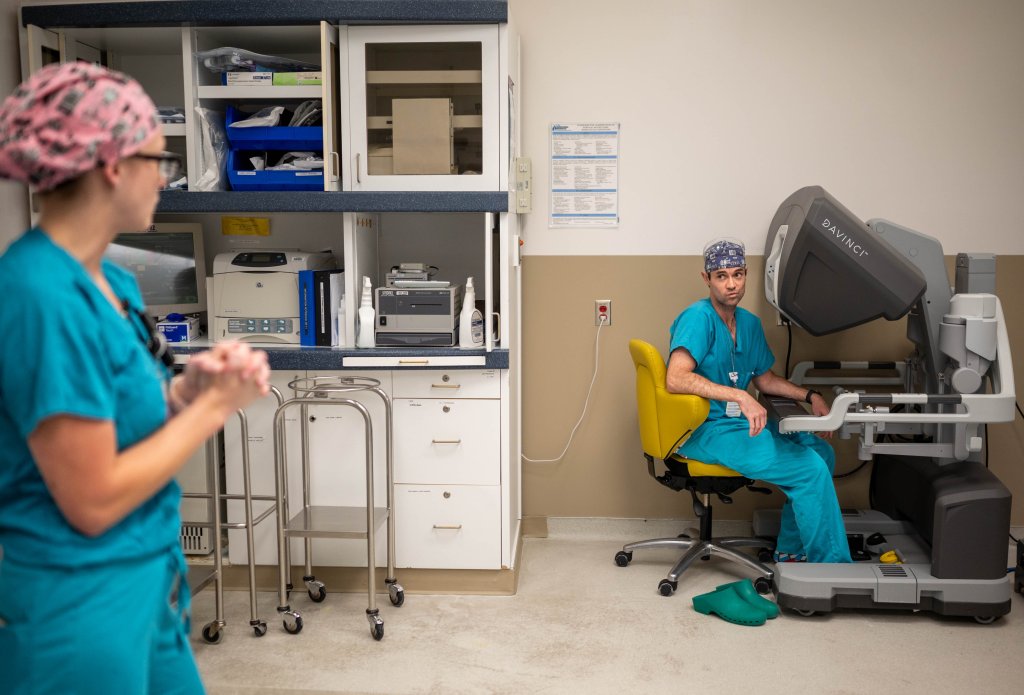
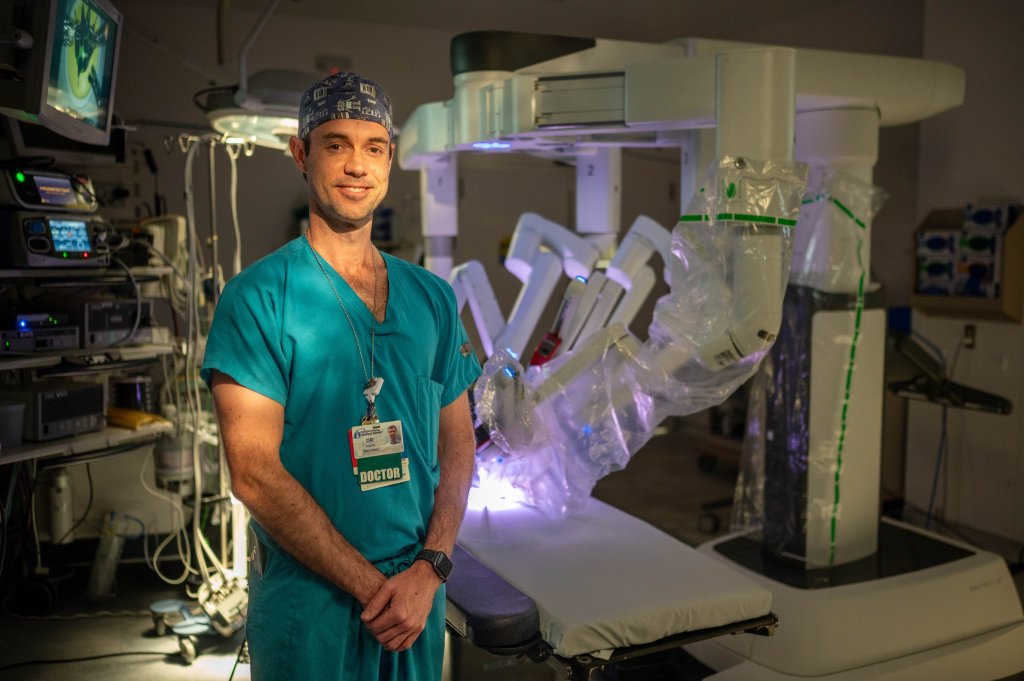
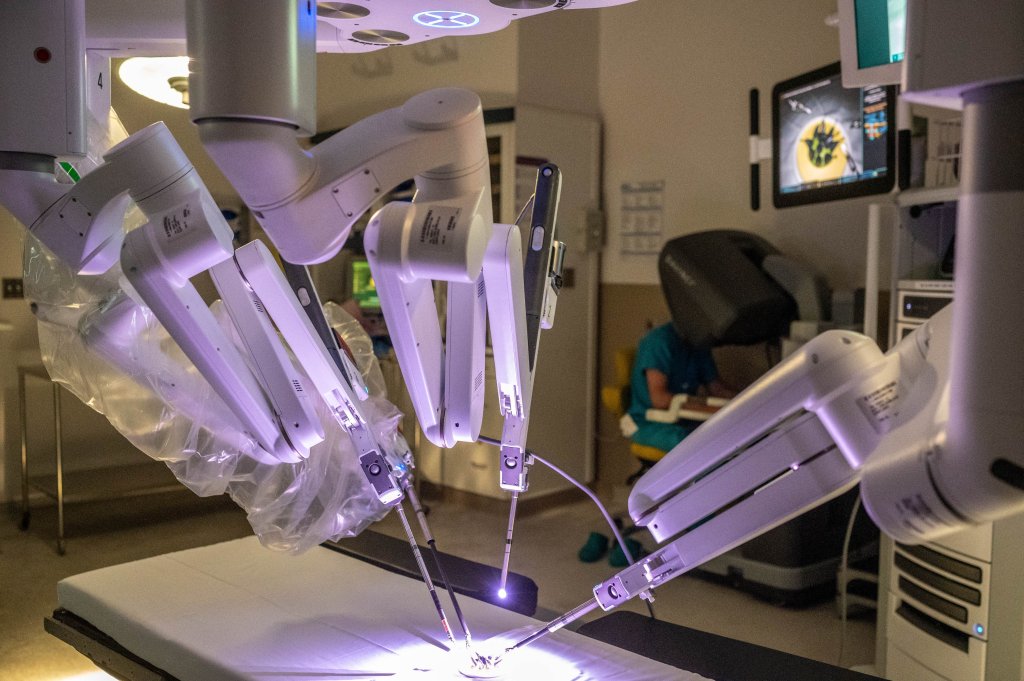
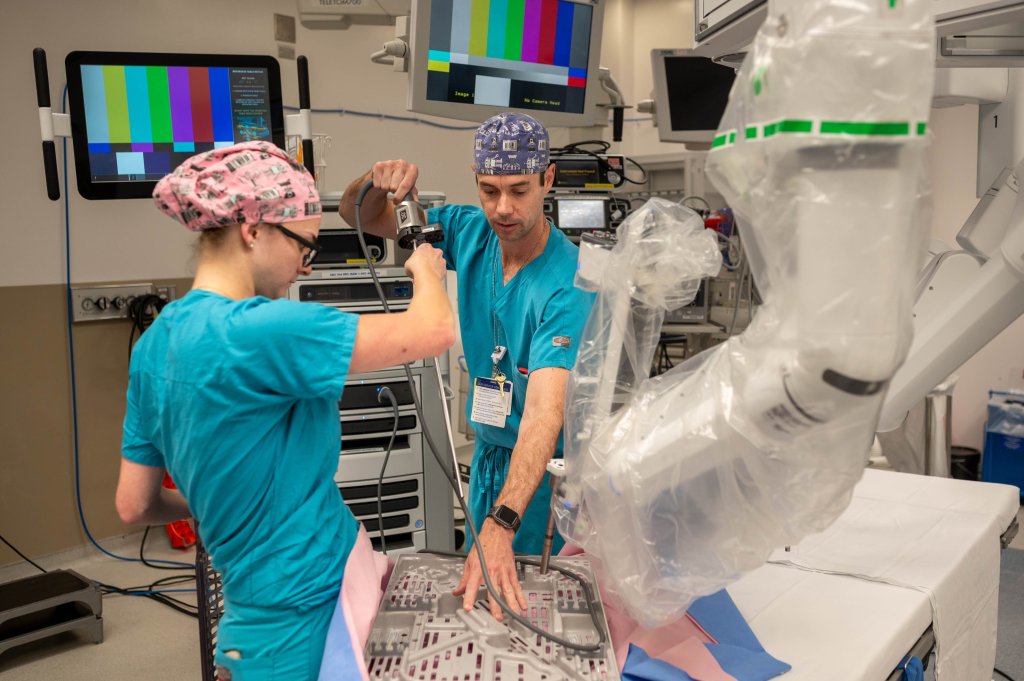
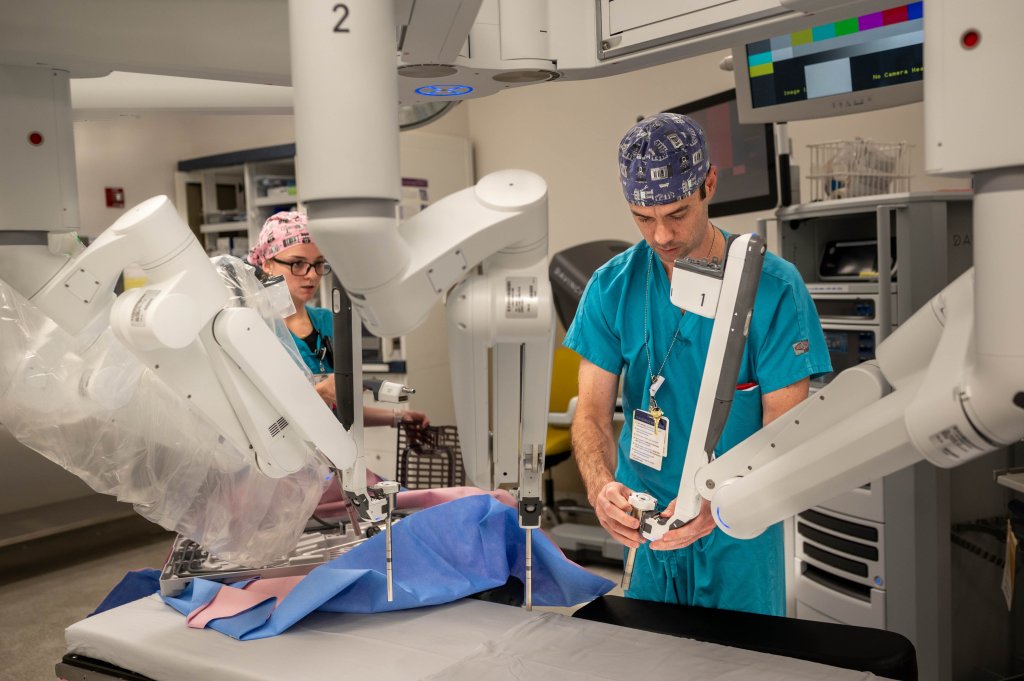
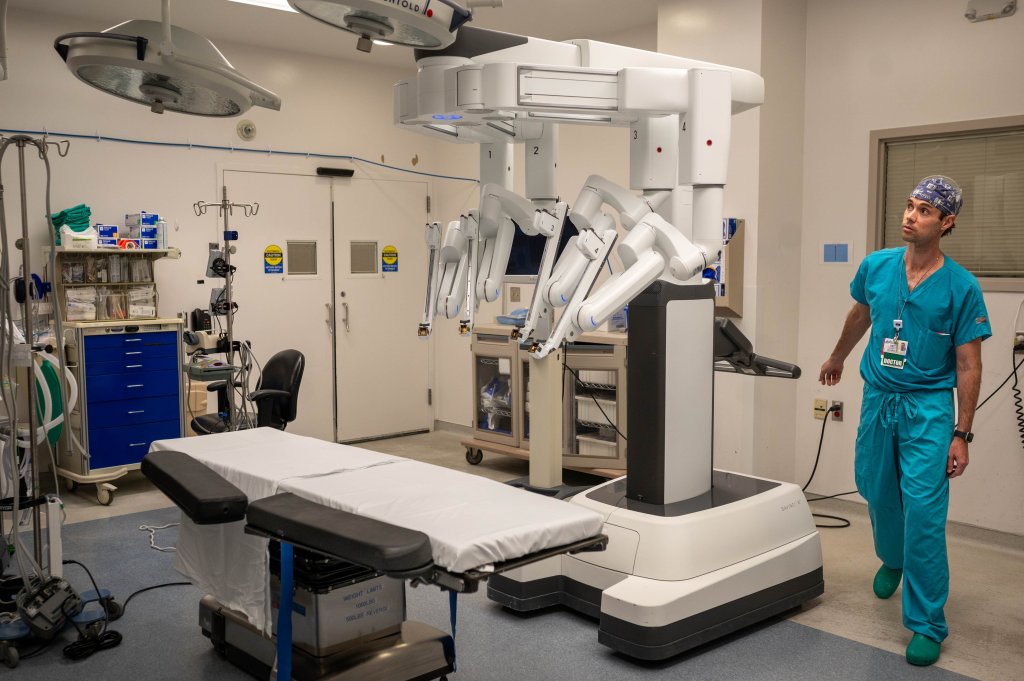
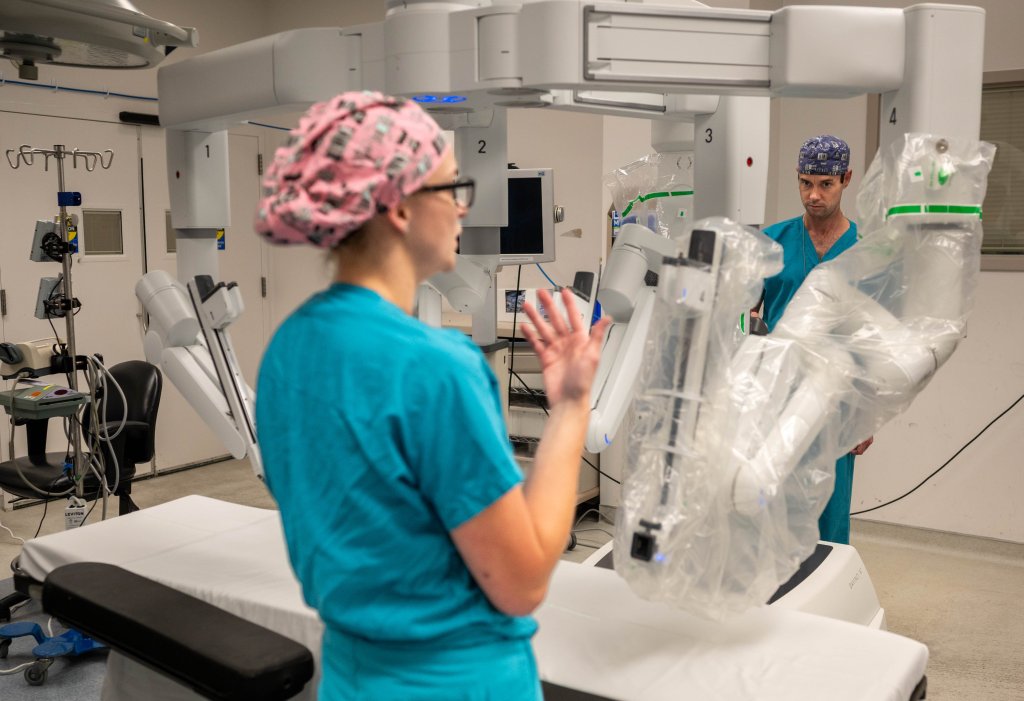

Comments are no longer available on this story